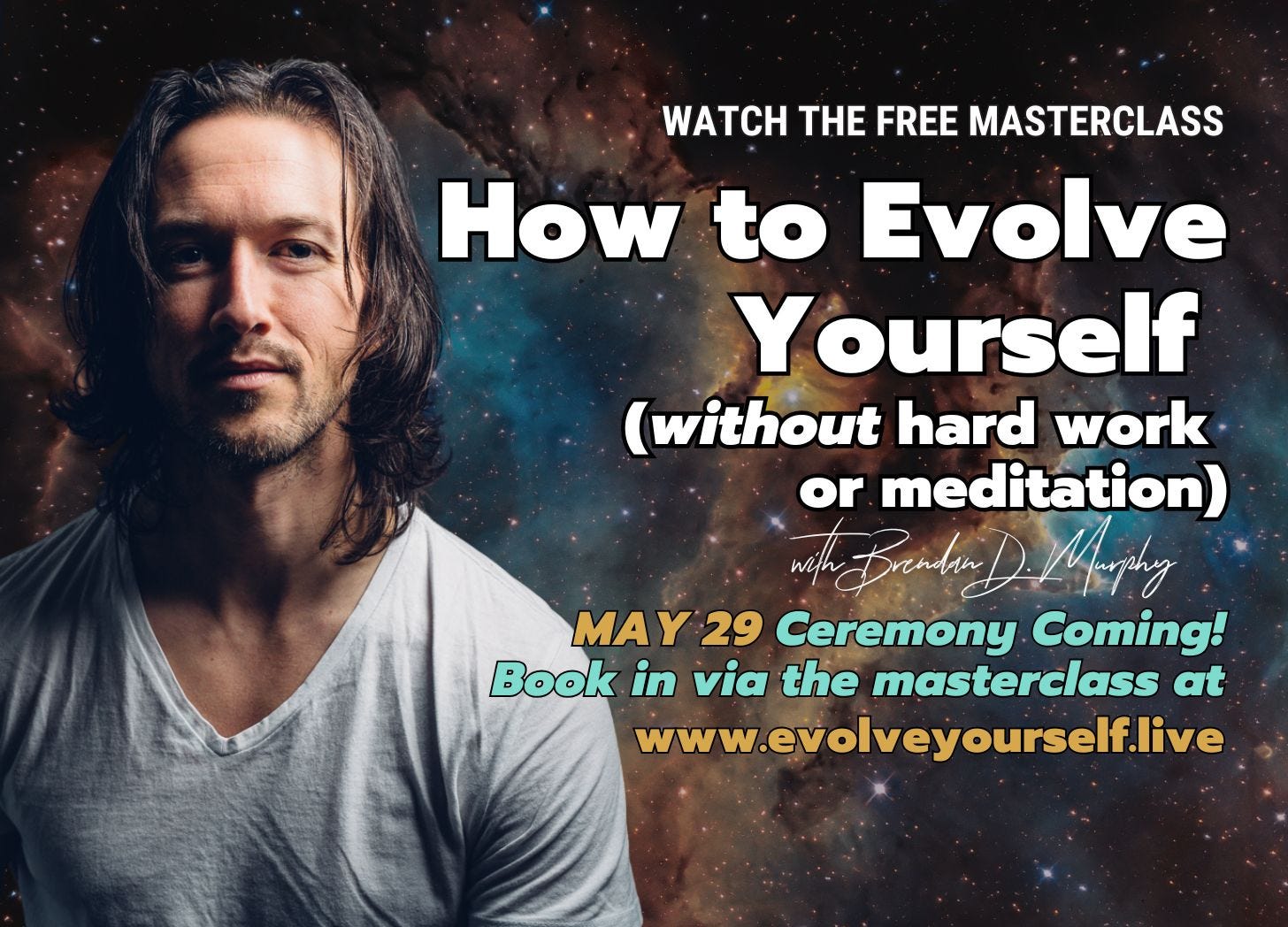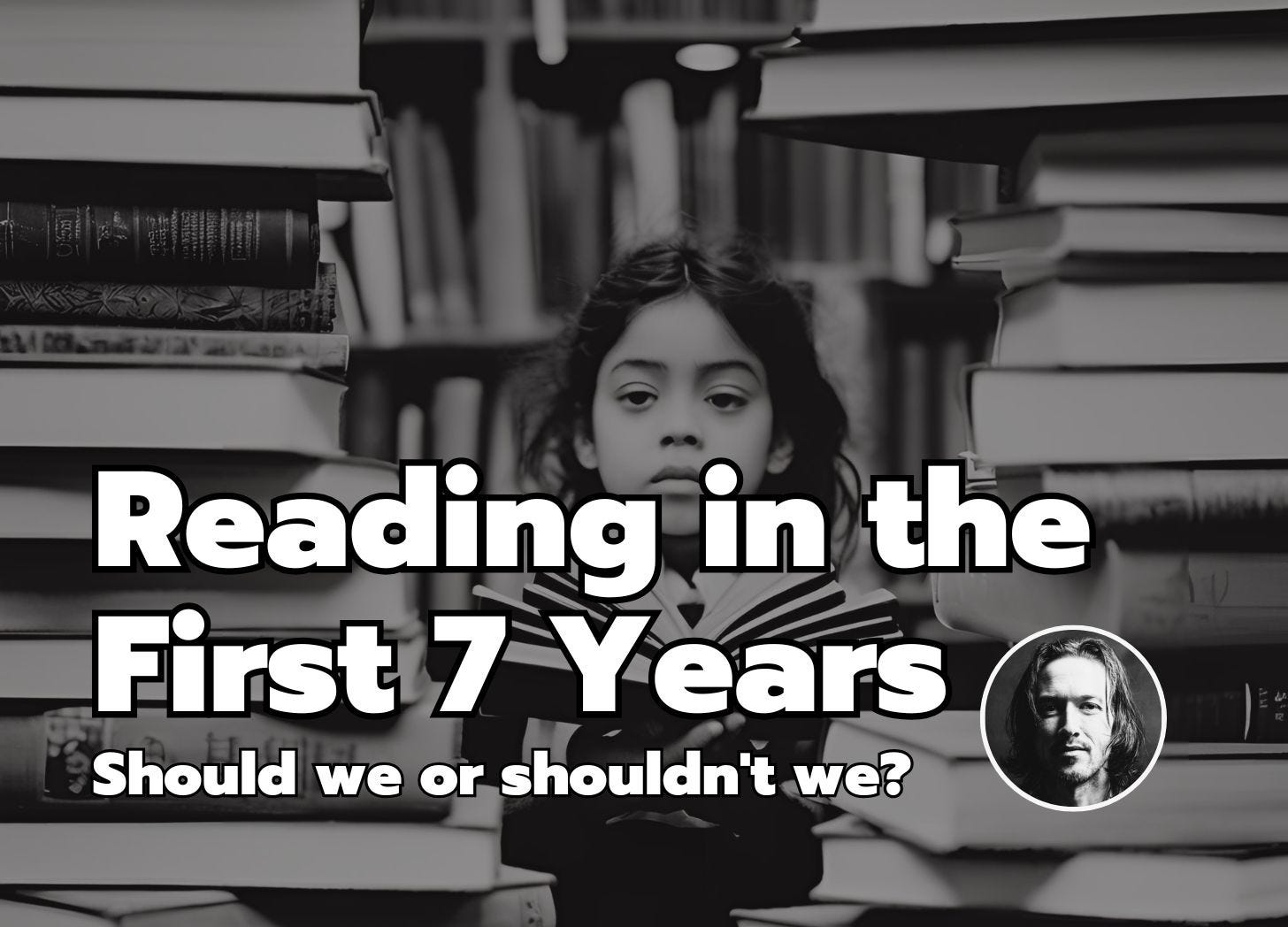Thanks for reading AWAKENING MINDS! Other ways I can support you (and vice versa)
⚠️ NEW LIVE CEREMONY: May 29th! Discover the life-changing and consciousness-expanding ➡️ EVOLVE YOURSELF biofield activations
Through my first book, THE GRAND ILLUSION: A SYNTHESIS OF SCIENCE & SPIRITUALITY - Book 1 📘 - 10,000 hours of research in 1 book
With a paid Substack subscription to get FULL Substack access (includes all audio 🎧 versions + comments on all pieces)
📕 Going paid ALSO helps me focus on getting Book 2 DONE and out to curious people like you! Thanks in advance for supporting.
Later you can find 2 other related pieces here, and its followup here—but start with this ⤵️
First Principles
I begin this piece with a passage from Richard Rudd’s book The Gene Keys:
“By the age of seven years old, most of your inherent patterns are already set in stone. It is therefore essential that children be given enormous amounts of time and space within their first seven years, as their natural dynamism needs to flow in an unimpeded manner.
Of course children need boundaries, but primarily, in their first seven years all they really need to do is play.
Play is dynamism exemplified...Sadly, in many cultures, mostly western, children are sent to school at some point within their first seven years and their natural seven-year cycle of unstructured play is interrupted.
This early emphasis on mental learning interferes with the child’s basic genetic need to express its dynamism through its body, rather than through its mind.
One of the reasons for modern society’s insistence on early learning is our misunderstanding of the difference between knowledge and genius.
There is a collective belief that genius is somehow a freak occurrence...There is also a collective belief that genius has to do with knowledge rather than intelligence. But true intelligence has nothing to do with the mind, even though it can manifest through the mind.
Genius is simply the fruit of a natural intelligence that has not been interfered with. Whereas knowledge can be forced, genius needs to be given a great deal of time and space to develop organically. The first seven years of a child’s life is the natural seeding time of their later genius.”1
I’m not sure whether Rudd simply tapped into this through his own intuitive wisdom, or if he studied Steiner or child psychology in depth—or some combination…
…but he’s absolutely nailed it.
When people better understand what a child (a human!) fundamentally IS and which developmental processes and stages they are moving through and when—in the same way weather patterns move through stages we call “seasons”—then we can simply let go of our irrational fetish for overly mentalised learning for young children (7 and under).
“Irrational fetish?!” you say? Already getting annoyed? Bear with me for a moment, I beseech thee.
What if…
…the obsession with intellectual learning for small children reveals a fundamental misunderstanding of what is needed and when (which season a child is in and how best to cultivate their terrain at the time)?
What if it also reveals—and this is too profound for me to flesh out properly in such a short post—a lack of long-term sensibility; what unforeseen effects might arise years and decades hence? Few people discuss such things—the thought does not even occur that there could (heaven forbid!) be a downside to our All-American can-do, go-getter mindset.
Aren’t we just supposed to carpe the shit out of the diem?
Seize the day, indeed! But after the day comes night, and what nightmares may supplant pleasant dreams if the day is not handled adroitly and with the delicateness nature demands?
What harvest will we reap if our seeds were not sown wisely?
As with many things in life, timing is everything. As any farmer knows, when you plant seeds the timing matters—assuming you want to eventually harvest a healthy crop.
Many still fail to grasp:
Nature is pure genius—and children are expressions of nature. They are not flawed; they do not suffer a congenital alphanumeric deficiency disease that needs “treatment” through analytical-mental activities at a young age. Their natural inclinations actually inform us as to their basic needs (if we pay close attention).
Clue: Children under 7 are perpetual motion machines, programmed to express and eventually master movement, limb, and will (expressing willfulness initially; later “will power” once matured and healthy).
The idea is to minimise needless interference with their innate organic processes, which can risk forcing their finely tuned and very BUSY bio-energetic systems into having to unnaturally divert energy away from essential developmental processes—like growing internal organs, for example (a huge task in itself—consider the bodily resources being utilised), developing the subtle etheric body, and, of course, basic physical expression.
This is to say nothing of the way the perpetual outflowing of their imaginative force can potentially be hampered (which has its own long-term consequences).
These vulnerable little beings learn and develop in the ways they need to, based on the season they’re in, quite beautifully without having times tables and alphabets shoved down their throats.
They aren’t circus animals here to perform parlour tricks or jump through arbitrary intellectual hoops based on decades of misguided social conditioning.
Guess what? It actually doesn’t matter if your 3-year-old can recite the alphabet start to finish, or count to 20 or not.
Why would it? Are they going to borrow your car and nip out to Starbucks for a frappe—and need to know how to count the change?
When a 2- or 3-year-old simply forgets how to count to 20, could it be a clue that such highly mental activities are actually not a high priority for their developing body-mind complex at that point in time?
Consider how utterly alien, new, and intimidating the world can be for a small child, a brilliant and vital being whose top priorities include amazing and novel (for them) things such as learning walking, speaking, climbing, getting dressed, dancing, mud kitchens, tying shoes, running, learning sharing, playing chasies with friends, and so on—things we adults now don’t give a second thought to.
We grownups have have left these delicate seasons of life behind and “moved on”—and, in the process, sadly forgotten much.
Are numbers and letters really the top priority for such a vulnerable little being still working through the stage of basic physical mastery and exploration, still developing their immature brain centres and connections at the slow and steady pace nature has decided upon over millennia?, still developing the vital/etheric body and the functions this vital principle will later support (such as will and memory to name two)?
If you really think so then you have a lot of catching up to do, friend.

The good news is the deep work has been done—for one thing, polymath visionary Rudolf Steiner laid it all out coherently 100 years ago, and it’s nice to see people gradually catching on. Modern neuroscience and child psychology—to say nothing of people carefully observing children day-to-day—have affirmed much of what he divined a century ago.
If we can stop thinking of small children as miniature adults—which they are manifestly not (in too many ways to account for in a short post like this)—then we can start allowing their mental unfoldment instead of trying to “help” (force) it before its time in inappropriate ways, based on a collectively conditioned state of hypnosis.
This hypnotic state has fostered a completely unnatural obsession with early intellectual development—an obsession that, as Steiner saw (literally saw clairvoyantly and intellectually) a century ago, can be deeply unhelpful in the optimal unfoldment of the child.
Everything has its season. (And I’m not suggesting passive neglect or slapping an iPad in their hands for 8 hours a day for “educational” or “edutainment” purposes qualifies as an appropriate way to “allow” a child’s “unfoldment”—far from it.)
Not to harp, but…
Do you wear your warm and woolies out in the peak summer heat?
No, because there is a much more optimal and beneficial time (season) to do so. The same principle applies to the development of the child, but the subtlety required of people in that domain is regrettably much greater. It may take some adjusting to—and the overcoming of some initial programmed resistance.
While some people have naively assumed/inherited the position—without taking a critical look—that not to “encourage” the young child to be able to read words on a page is “holding back their development,” a more informed position recognises that it may in fact have the exact opposite effect in the long run.
By all means, read them stories, let them guess at numbers and letters—my 4-year-old girl likes to write some down occasionally—but for their sake, remember which “season” you’re in.
Yes, it can be done: you CAN force them to become more analytical and to start forming words and sentences out of the letters, but just because something CAN be done does that mean it SHOULD?
If I’m feeling cold, I COULD turn my oven up to 200°C, climb in and shut the door—but to what end—would it be wise? Could there be a better way to get warm?
Alternative methods such as the Sudbury Valley School approach have shown definitively that young children (7 and under) are not remotely disadvantaged by NOT being forced to learn to read early. In fact, this approach minimises needless imposed mental interference with their organic unfoldment—it is more self-directed: when the child wants to learn something they simply ask. A tutor and/or other resources will be provided.
Lo and behold, these “deprived” children spontaneously discover their own intellectual pursuits and passions through uncoerced unfoldment—and reveal an innate genius that otherwise might have been buried and obscured under a tsunami of unnecessary intervention and diversion of their innate processes into hyper-mental activity.
When Sudbury kids decide it’s time to learn to read—perhaps even as late as 10 years of age—they learn FAST.2

I will begin wrapping up with some words from British educator L. Francis Edmunds (1979), who encouraged us to pause and reflect:
We must ask what we we doing to children when we begin to intellectualize them, by teaching reading before they are ready? In the [1930s] there was issued a Hadow Report based on a government research project. It strongly advocated that children should not be taught reading before the age of six; but who attends to this today? Who will recognize that premature educational demands on the child vitiate the life forces needed for further development later?
…Then, at the opposite end, in public life, we see how incapable human beings are to cope with the problems that beset them…Might we not consider that these conditions have their source in the early years, and what further harm do we do by exposing children to the floods of unassimilable television? Pictures?…How far do we actually wreck young lives through careless regard for what childhood actually is and what are its rightful needs?3
Edmunds goes on to mention the head of the education department at a large American university who ran an experiment over a number of years which compared two groups of children drawn from the same milieu:
In the one group the children were taught reading by the usual methods, with its demands at the expense of the slower child. In the other group the conditions held were more relaxed; there was a willingness to allow the children to arrive at reading in their own time…He found without question that the second group by the age of twelve outstripped the first…4
Clearly the “disadvantage” lies not with the children who aren’t forced to read early. How many people realise research and observation was already taking place decades ago—in fact, a century or more, if we factor in Steiner’s pioneering work.
As Rahima Dancy points out:
Children under the age of six should not be expected to copy sentences. Meaningful copying requires brain maturation to integrate two or three modalities (looking, feeling, moving and sometimes even hearing a word). Little ones can copy at a rote level, but they’re probably not using the circuits which will connect with meaning. Let it wait. Children of this age should not be sitting at desks doing academic tasks. Get their busy brains out doing and learning, not practicing low-level skills.5
Waldorf pedagogy takes an infinitely more subtle and integrated—and less superficial—approach to learning than any other I have seen so far, recognising the truly vital importance of the imaginative principle/faculty for young children.
It is disappointing to see people publicly make strawman criticisms of the Waldorf approach while blatantly having not done the research—this, frankly, is a disservice to everyone.
Few people—including critics—have any glimmering of how critical the child’s faculty of imagination is:
It is upon this ground of imagination that the later powers of intellect, judgment, and critical thinking will be based. Therefore, all of the subjects—from reading to mathematics to physics—are taught in an imaginative and artistic way in the Waldorf elementary school, providing a rich and nourishing foundation for the faculty of analytical thinking that arises and can be developed in puberty.6
I had a great chat with a rather under-informed Waldorf dad recently—a great and intelligent guy—who just happened to not have a clue about how the pedagogy worked (his wife did though, which is why their kid attends the school). He had attended an open day where he got to “role play” being a student in class and experience the way in which letters were taught to the kids.
Not knowing what to expect initially, he was struck by the power of the carefully thought-out holistic method—a light bulb went off for him and he started to realise the value in the approach.
It was a nice moment.
Too many Waldorf parents sadly view the school like a normie day care centre—such a wasted opportunity (and not a helpful influence within the ecology of the school!).
Finally, to ram home the value of developing perspective and not merely succumbing to the persistent modern fad and fetish of early hypermentalism, I share below a very short story from Edmunds, who was well aware of the blinkered idea that we “lose” huge learning possibilities by “delaying” reading, and that it should therefore be seen as desirable to “start ‘em young.” (This outdated criticism reveals the hyper-mental obsession and lack of awareness of more subtle aspects of childhood development needing tending to.)
Edmunds recounts a large teachers conference held in Canada where one of the guest speakers, a man of public standing, enthusiastically described how one of his children—just 3 years of age—had already learned how to read. It was seen as a “major achievement and was greeted with loud applause,” of course, by the Promethean spirit of the audience.
But what came next must have been rather a shock to the poor fellow, and was an unfortunate result of the organisers’ programming, because the very next speaker was to present a talk that completely undermined his message.
In short, this next teacher—with a more rounded and nuanced perspective—outlined some of the less obvious reasons why teaching a three-year-old to read might actually not be such a wondrous thing.
Some of the points made by this man spoke to those subtleties and long-range sensibilities already mentioned (or hinted at) here. He invited the audience to consider whether making such a young child read might force a
“considerable degree of mental concentration, therefore of greater wakefulness. We might say we draw it more strongly into its nerve-senses, more strongly than [normal]…that we produce, to that extent, a premature ageing process [beginning at the energetic level, not a visible ageing]. It counters the liveliness of childhood behaviour and experience—we draw them away from the life of their limbs and into their heads.”7
The second speaker’s talk ended with a considered silence as the deep ramifications sank in; then slow applause, building to sustained and protracted applause.
Something landed.
As a parent I notice the way my little girl loves to have me read a story and then immediately start it all over again as soon as it’s done. I see the way her imagination engages with the spoken words and basic (static) images to weave her own inner imaginative experience—and how she likes to have the space to marinate in this inner world for as long as need be. (Immersive, imagination-driven experience is key for under-7s.)
This is a precious and delicate season/stage I will not interfere with through imposed mental gymnastics designed to meet entirely arbitrary academic or social standards—there are no do-overs.
As an aside, I found out recently—without prompting—that my little one can count to 40, but this wasn’t because of Aimee or I training her. It probably happened through school, but if Waldorf children are taught numbers it is done in an integrated way suitable to their developmental stage and needs, rather than just being a shallow mental exercise in rote learning. The numbers (or letters) are meaningfully connected to real-world things that engage their sensory systems and imaginations—it is not a reductive, strictly intellectual process (such processes are more appropriate later on).
In the case of young children like her, she may have learned how to count that high through song—a popular and very effective device used in Waldorf pedagogy. Probably she experienced counting to lower numbers in some songs and then figured out the rest herself—Waldorf pedagogy doesn’t involve drilling such youngsters in counting “high” for the sake of it.
What is learned through song non-intellectually (and non-consciously) has a way of sticking in the memory bank though.
One of the songs she brought home this year featured counting the 7 colours of the rainbow—which she recites from memory effortlessly, according to the melody. Intellectually the dry fact of a rainbow having 7 colours is not yet a fully fledged concept for her, but she can tell you them all through song—along with many other song-based factoids she’s learnt along the way.
Children’s memory for song is truly jaw-dropping.
A quote from Steiner about the hypermental tendency of modernity seems apt as we wrap up:
"Negatively, it means that every attempt to teach young children analytical, conceptual thinking—the wide-spread efforts to teach reading, calculating, and computer skills at an ever earlier age—is premature, and a destructive intrusion that threatens the full development of the tacit knowing so necessary for truly powerful, creative, and self-confident thinking in later life."8
Among a cornucopia of other observables, the fact that children’s brainwave signatures are quite different from grown adults’ (more theta-dominant, for instance, and with less coherence between different regions9) should remind us that we are not simply dealing with tiny adults, but amazing developing beings requiring a much more delicate and nuanced approach than we have—with a few noted exceptions—hitherto utilised in the hyper-mental “can do” modern era of unintegrated and shallow learning.
“We have lost touch with natural processes in child development, convinced that we have to ‘do something’ rather than allowing the child’s own inner processes to unfold.” - Rahima B. Dancy
The question of precisely how best to optimally go about allowing that unfoldment—from an informed and nuanced place—is beyond this already too-bloated post, so I make some reading suggestions below.
Further reading
The Way of a Child - A. C. Harwood
The Education of the Child - Steiner
An Introduction to Waldorf Education and Other Essays - Steiner
The Child’s Changing Consciousness as the Basis of Pedagogical Practice - Steiner
The Kingdom of Childhood - Steiner
Rudolf Steiner Education - L. Francis Edmunds
Free at Last: The Sudbury Valley School - Greenberg
Reclaiming Early Childhood - Suggate & Suggate
You Are Your Child’s First Teacher - Rahima B. Dancy
Understanding Waldorf Education - Jack Petrash
Simplicity Parenting - Kim J. Payne
The Soul of Discipline - Kim J. Payne
Anything about child psychology and early development by Jean Piaget
Additional resources
Spoken Waldorf stories on Spotify by We Nurture: Waldorf Inspired Parenting (a great way to let your little one’s imagination engage strongly with age-appropriate material, without the imagination-negating effects of moving images on screens, nor the risk of exposure to unhelpful themes and imagery).
Kids’ Books
There is a large assortment of Waldorf style story books out there. I may provide a list of some of our own in future. :)
About Brendan & His Other Offers
Brendan D. Murphy is the “consciousness guy” and author of the critically acclaimed epic, “The Grand Illusion: A Synthesis of Science and Spirituality — Book 1”

Get on the wait list for the astonishing Book 2 of “The Grand Illusion”
Burnt-out Business Owners & Entrepreneurs Only > “FREEDOM ON TAP”: Discover a leveraged, highly automated way to build income online to reclaim your time freedom: free 90 minute training (watch it in one go and right to the end, as your place in the video won’t be saved if you close the tab or window).
📲 Follow Brendan’s Instagram and BitChute (@BrendanDMurphyOfficial)
🧬 LEAVING SOON! ➡️ Watch the FREE How to Evolve Yourself (WITHOUT Hard Work or Meditation) Masterclass to learn about Brendan's potent evolutionary biofield activation and healing work with sound. This offer will likely be ended for good in 2025.
Rudd, The Gene Keys, 306.
See Greendberg, Free at Last: The Sudbury Valley School
Edmunds, Rudolf Steiner Education, 24.
Ibid., 25.
Dancy, You Are Your Child’s First Teacher, 228.
Ibid., 248.
Edmunds, 25-26.
See Steiner (with Everett Roland), "Child's Changing Consciousness: As the Basis of Pedagogical Practice, 8 lectures, Dornach, Switzerland, 1923"
Thatcher, R. W., Walker, R. A., & Giudice, S. (1987). Development of cortical connections as measured by EEG coherence and phase delays. Developmental Neuropsychology, 3(4), 257–277. https://doi.org/10.1080/87565648709540324
Thatcher, R. W., North, D., & Biver, C. (2005). EEG and intelligence: Relations between EEG coherence, EEG phase delay and power. Clinical Neurophysiology, 116(9), 2129–2141. https://doi.org/10.1016/j.clinph.2005.04.026
Marshall, P. J., Bar-Haim, Y., & Fox, N. A. (2002). Development of the EEG from 5 months to 4 years of age. Clinical Neurophysiology, 113(8), 1199–1208. https://doi.org/10.1016/S1388-2457(02)00163-3
Gasser, T., Verleger, R., Bächer, P., & Sroka, L. (1988). Development of the EEG of school-age children and adolescents. I. Spectral analysis. Electroencephalography and Clinical Neurophysiology, 69(2), 91–99. https://doi.org/10.1016/0013-4694(88)90204-2
Miskovic, V., & Schmidt, L. A. (2010). Cross-regional cortical synchronization during affective image viewing in 6- to 10-year-old children. Biological Psychology, 84(2), 333–340. https://doi.org/10.1016/j.biopsycho.2010.03.001





